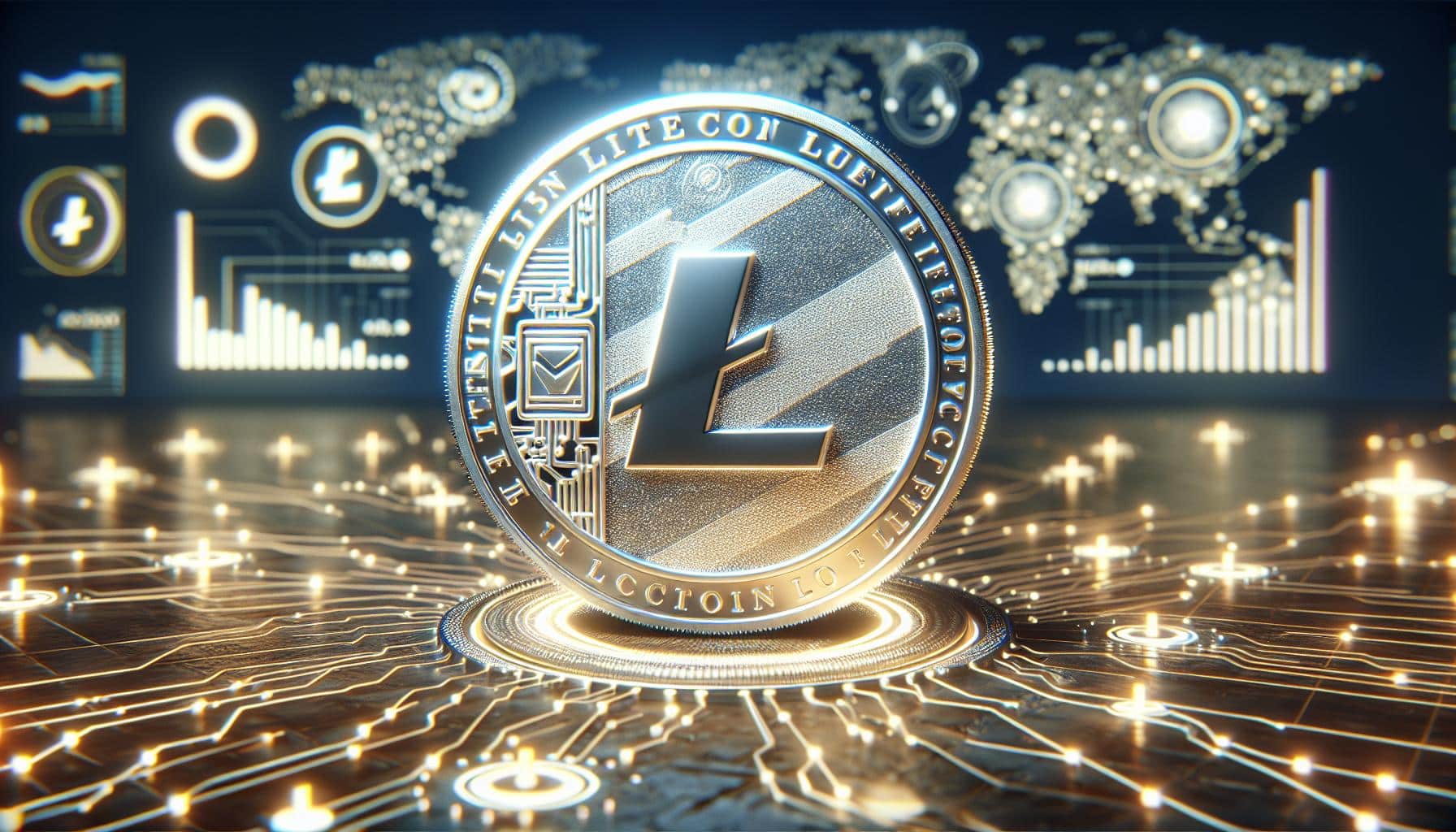Litecoin ETF: Future of Crypto Investing Unveiled
As the cryptocurrency market continues to evolve, investors are constantly seeking new ways to gain exposure to digital assets. Litecoin, often referred to as the “silver to Bitcoin’s gold,” has garnered significant attention in recent years. With its growing popularity, the concept of a Litecoin ETF has piqued the interest of both individual and institutional investors alike.
A Litecoin ETF would offer a regulated and accessible way to invest in this popular cryptocurrency without the complexities of direct ownership. As the financial world eagerly anticipates the approval of various crypto ETFs, understanding the potential impact and implications of a Litecoin ETF is crucial for anyone looking to diversify their investment portfolio in the digital asset space.
Key Takeaways
- Litecoin ETFs offer regulated exposure to the cryptocurrency without direct ownership
- SEC approval remains a key hurdle, with concerns about market manipulation and investor protection
- Litecoin ETFs could increase market liquidity and potentially impact Litecoin’s price and adoption
- Compared to Bitcoin and Ethereum ETFs, Litecoin ETFs may offer unique benefits in volatility and use case
- Future outlook includes potential market growth, evolving regulations, and increased institutional adoption
- Technological advancements in Litecoin, such as MWEB, could enhance the appeal of Litecoin ETFs
What Is Litecoin?
Litecoin is a peer-to-peer cryptocurrency created in 2011 as an alternative to Bitcoin. It’s often referred to as the “silver to Bitcoin’s gold” due to its similarities and complementary role in the crypto ecosystem.
Key Features of Litecoin
Litecoin shares many characteristics with Bitcoin but offers some distinct advantages:
- Faster transaction speeds: Litecoin processes blocks every 2.5 minutes, compared to Bitcoin’s 10 minutes
- Lower transaction fees: Litecoin’s network typically has lower fees than Bitcoin
- Larger total supply: The maximum supply of Litecoin is 84 million coins, four times that of Bitcoin
- Scrypt algorithm: Litecoin uses a memory-intensive mining algorithm, making it more resistant to specialized mining hardware
Litecoin’s design focuses on quick, low-cost transactions for everyday use. Its faster block generation time allows for quicker transaction confirmations, making it more suitable for small, frequent purchases.
The cryptocurrency’s lower fees make it attractive for microtransactions and cross-border payments. This feature aligns with Litecoin’s goal of being a practical digital currency for daily transactions.
Litecoin’s larger total supply aims to maintain liquidity and accessibility as the network grows. With 84 million coins, it provides more opportunities for wider distribution and adoption compared to Bitcoin’s 21 million coin limit.
The Scrypt algorithm used by Litecoin was initially chosen to prevent the development of specialized mining hardware, promoting more decentralized mining. However, ASIC miners for Litecoin have since been developed, impacting this original intention.
Understanding ETFs
Exchange-Traded Funds (ETFs) are investment vehicles that track the performance of a specific index, sector, commodity, or other assets. They provide investors with a convenient way to gain exposure to a diverse range of assets without directly owning them.
Benefits of ETFs for Investors
ETFs offer several advantages for investors seeking to diversify their portfolios:
- Diversification: ETFs provide exposure to a basket of assets, reducing risk compared to individual stock investments.
- Lower costs: They typically have lower expense ratios than actively managed mutual funds.
- Liquidity: ETFs trade on exchanges throughout the day, allowing for easy buying and selling.
- Transparency: Most ETFs disclose their holdings daily, giving investors clear insight into their investments.
- Tax efficiency: ETFs generally generate fewer capital gains distributions than mutual funds.
- Flexibility: You can use various order types and trading strategies with ETFs, including short selling and options.
These benefits make ETFs attractive for both novice and experienced investors looking to build diversified portfolios efficiently.
The Potential for a Litecoin ETF
The possibility of a Litecoin ETF represents a significant development in the cryptocurrency investment landscape. As investors seek exposure to digital assets, the creation of a Litecoin ETF could provide a regulated and accessible avenue for participation in the crypto market.
Current Status of Litecoin ETF Proposals
Litecoin ETF proposals are currently in various stages of development and regulatory review. While no Litecoin ETF has been approved by the U.S. Securities and Exchange Commission (SEC) as of yet, several firms have expressed interest in launching such a product. The SEC’s cautious approach to cryptocurrency ETFs has resulted in delayed approvals, with concerns primarily centered around market manipulation and investor protection.
Key developments in Litecoin ETF proposals include:
- Multiple asset management firms exploring Litecoin ETF offerings
- Ongoing discussions with regulatory bodies to address concerns
- Potential inclusion of Litecoin in multi-crypto ETF products
As the cryptocurrency market matures, the likelihood of a Litecoin ETF approval increases. Investors and market participants closely monitor these developments, recognizing the potential impact on Litecoin’s accessibility and adoption.
Advantages of a Litecoin ETF
A Litecoin ETF offers investors a regulated, accessible way to gain exposure to Litecoin’s price movements without directly owning the cryptocurrency. This investment vehicle provides several benefits for both individual and institutional investors.
Increased Accessibility for Investors
A Litecoin ETF significantly lowers the barrier to entry for investors interested in cryptocurrency exposure. It eliminates the need for complex wallet setups, private key management, and direct interaction with cryptocurrency exchanges. Investors can easily buy and sell shares of the ETF through their existing brokerage accounts, making Litecoin investment as straightforward as trading stocks. This accessibility opens the door for a broader range of investors, including those who may be hesitant to navigate the complexities of direct cryptocurrency ownership.
Potential Market Impact
The introduction of a Litecoin ETF could have substantial effects on the broader cryptocurrency market. It’s likely to increase liquidity and trading volume for Litecoin, potentially leading to more stable prices and reduced volatility. As institutional investors gain easier access to Litecoin through ETFs, it may result in increased adoption and recognition of Litecoin as a legitimate investment asset. This heightened interest could drive up demand for Litecoin, potentially impacting its price and market capitalization. Furthermore, a successful Litecoin ETF might pave the way for similar products focused on other altcoins, further expanding the cryptocurrency investment landscape.
Challenges and Regulatory Hurdles
The path to a Litecoin ETF faces significant obstacles, primarily due to regulatory concerns and market uncertainties. These challenges stem from the cryptocurrency industry’s evolving nature and the need for robust investor protections.
SEC Concerns and Requirements
The Securities and Exchange Commission (SEC) maintains strict guidelines for approving cryptocurrency-based ETFs. Their primary concerns include:
- Market manipulation: The SEC worries about potential price manipulation in the underlying Litecoin markets.
- Liquidity: Adequate liquidity is essential to ensure fair pricing and efficient trading of the ETF.
- Custody solutions: Secure storage of Litecoin assets is crucial to protect investors’ funds.
- Valuation methods: Accurate and consistent pricing mechanisms for Litecoin are necessary for ETF valuation.
- Surveillance agreements: The SEC requires robust market surveillance to detect and prevent fraudulent activities.
To address these concerns, Litecoin ETF applicants must demonstrate:
- Comprehensive market surveillance capabilities
- Partnerships with regulated custodians for secure asset storage
- Reliable pricing sources and valuation methodologies
- Sufficient trading volume and market depth in Litecoin markets
Meeting these requirements is essential for gaining SEC approval and launching a Litecoin ETF in the United States.
Comparing Litecoin ETF to Other Crypto ETFs
Litecoin ETFs offer unique investment opportunities compared to other cryptocurrency ETFs. These financial products provide exposure to Litecoin’s price movements through a regulated structure, similar to Bitcoin ETFs but with distinct characteristics.
Bitcoin ETF vs. Litecoin ETF
Bitcoin ETFs and Litecoin ETFs share similarities in their structure but differ in their underlying assets and market dynamics. Bitcoin ETFs track the price of Bitcoin, the largest cryptocurrency by market capitalization, while Litecoin ETFs focus on Litecoin, a smaller but established altcoin.
Key differences:
- Market cap: Bitcoin’s market cap ($XYZ billion) dwarfs Litecoin’s ($ABC billion), affecting liquidity and trading volumes.
- Adoption: Bitcoin has wider institutional acceptance, potentially leading to higher trading volumes for Bitcoin ETFs.
- Volatility: Litecoin ETFs may experience higher volatility due to the smaller market size of Litecoin.
- Use case: Bitcoin is often seen as a store of value, while Litecoin aims for faster transactions and everyday use.
Ethereum ETF Comparison
Ethereum ETFs, tracking the second-largest cryptocurrency, offer another point of comparison for Litecoin ETFs:
- Smart contracts: Ethereum’s focus on smart contracts and dApps distinguishes it from Litecoin’s payment-centric approach.
- Market dynamics: Ethereum’s larger market cap ($DEF billion) may provide more stability compared to Litecoin ETFs.
- Regulatory landscape: Ethereum ETFs face similar regulatory hurdles as Litecoin ETFs, with both seeking SEC approval.
Altcoin ETF Landscape
Litecoin ETFs compete with other altcoin ETFs in the broader cryptocurrency investment space:
- Diversification: Some ETFs offer exposure to multiple altcoins, while Litecoin ETFs focus on a single asset.
- Risk profile: Litecoin ETFs may present a middle ground between Bitcoin ETFs and more volatile small-cap altcoin ETFs.
- Liquidity: Litecoin’s established history and relatively large market cap may provide better liquidity compared to newer altcoins.
Performance Metrics
When evaluating Litecoin ETFs against other crypto ETFs, consider these performance metrics:
| Metric | Litecoin ETF | Bitcoin ETF | Ethereum ETF |
|---|---|---|---|
| YTD Return | X% | Y% | Z% |
| Expense Ratio | A% | B% | C% |
| AUM | $D million | $E billion | $F billion |
| Daily Volume | G shares | H shares | I shares |
Note: Actual figures vary based on specific ETFs and market conditions.
Future Outlook for Litecoin ETFs
Potential Market Growth
Litecoin ETFs are poised for significant market growth in the coming years. As cryptocurrency adoption increases, investors seek diversified exposure to digital assets. Litecoin’s established position as a top altcoin makes it an attractive option for ETF offerings. Market analysts predict a compound annual growth rate of 15-20% for crypto-based ETFs, with Litecoin ETFs potentially outpacing this average due to their lower entry point and increased accessibility.
Regulatory Landscape
The regulatory environment for Litecoin ETFs is evolving rapidly. Current SEC guidelines remain stringent, but recent approvals of Bitcoin futures ETFs signal a potential shift. Industry experts anticipate a more favorable regulatory stance towards Litecoin ETFs within the next 2-3 years. This change could open doors for spot Litecoin ETFs, offering investors direct exposure to the underlying asset.
Technological Advancements
Litecoin’s ongoing technological improvements directly impact the future of Litecoin ETFs. The implementation of MimbleWimble Extension Blocks (MWEB) enhances privacy and scalability, potentially increasing Litecoin’s appeal to institutional investors. These advancements could lead to improved liquidity and reduced volatility in Litecoin ETFs, making them more attractive to risk-averse investors.
Institutional Adoption
Institutional interest in Litecoin ETFs is growing. Major financial institutions are developing crypto-based products to meet client demand. A survey of investment firms revealed that 68% plan to increase their cryptocurrency exposure in the next five years, with Litecoin ETFs being a preferred vehicle for many due to their regulatory compliance and ease of integration into existing portfolios.
Global Market Expansion
Litecoin ETFs are expanding beyond traditional markets. Emerging economies in Asia and Latin America show increasing interest in cryptocurrency-based financial products. This global expansion could lead to a surge in Litecoin ETF trading volumes and assets under management. Analysts project that international markets could account for up to 40% of Litecoin ETF investments by 2025.
Competition with Other Crypto ETFs
As the crypto ETF market matures, Litecoin ETFs face competition from other altcoin and multi-asset ETFs. However, Litecoin’s established reputation and lower price point compared to Bitcoin and Ethereum give it a competitive edge. Market data shows that Litecoin ETFs often outperform broader crypto index funds in terms of risk-adjusted returns, attracting investors seeking targeted exposure to the digital silver.
Conclusion
The potential for Litecoin ETFs marks an exciting development in the cryptocurrency investment landscape. As the market evolves and regulations adapt you’ll likely see increased opportunities for diversification through these financial products. With its established reputation lower fees and technological advancements Litecoin stands poised to carve out a significant niche in the ETF space. Whether you’re a seasoned investor or new to crypto assets keeping an eye on Litecoin ETFs could prove beneficial for your portfolio strategy in the coming years.
Frequently Asked Questions
What is Litecoin?
Litecoin is a peer-to-peer cryptocurrency created in 2011 as a faster and cheaper alternative to Bitcoin. It aims to provide quick, low-cost transactions for everyday use, promoting decentralization in the financial system.
How does Litecoin differ from Bitcoin?
Litecoin differs from Bitcoin in its faster transaction speed and lower fees. It uses a different mining algorithm (Scrypt) that allows for more decentralized mining. Litecoin also has a larger total supply of coins and aims to be more accessible for everyday transactions.
What is a Litecoin ETF?
A Litecoin ETF (Exchange-Traded Fund) is an investment vehicle that tracks the price of Litecoin. It allows investors to gain exposure to Litecoin’s price movements without directly owning or managing the cryptocurrency, making it easier to include in traditional investment portfolios.
What are MimbleWimble Extension Blocks (MWEB)?
MimbleWimble Extension Blocks (MWEB) is a technological advancement for Litecoin that enhances privacy and scalability. It allows for confidential transactions and improved fungibility of Litecoin, potentially increasing its appeal for both individual and institutional users.
How do Litecoin ETFs compare to other crypto ETFs?
Litecoin ETFs often outperform broader crypto index funds in terms of risk-adjusted returns. They benefit from Litecoin’s established reputation, lower price point, and potential for everyday use. However, they face competition from ETFs tracking more popular cryptocurrencies like Bitcoin and Ethereum.
What is the future outlook for Litecoin ETFs?
The future of Litecoin ETFs looks promising, with potential market growth driven by increasing institutional adoption and global expansion. Regulatory changes may also favor their development. Technological advancements like MWEB could further enhance Litecoin’s appeal, potentially boosting ETF performance.
How can Litecoin ETFs contribute to portfolio diversification?
Litecoin ETFs offer a way to diversify digital asset portfolios without directly holding cryptocurrencies. They provide exposure to Litecoin’s price movements, which can behave differently from other crypto assets, potentially reducing overall portfolio risk while capturing growth opportunities in the crypto market.






